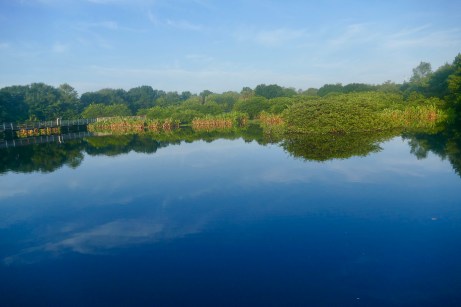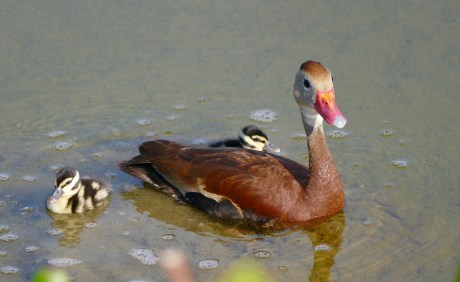 It’s hard to believe that these very same tree islands were bustling with noisy (and sometimes smelly 😏) nesting wood storks, herons, and egrets of all shapes and sizes just two months ago.
It’s hard to believe that these very same tree islands were bustling with noisy (and sometimes smelly 😏) nesting wood storks, herons, and egrets of all shapes and sizes just two months ago.  Almost everyone has moved on. This morning the boardwalks were empty and quiet and the ponds were utterly still.
Almost everyone has moved on. This morning the boardwalks were empty and quiet and the ponds were utterly still.  What a tranquil time to take a walk and admire the lovely Fireflag 👆and Duck Potato 👇 blossoms~!
What a tranquil time to take a walk and admire the lovely Fireflag 👆and Duck Potato 👇 blossoms~!  Very few birds and very few people were out and about just after sunrise today – unlike the crowds we see during our winter ‘season’. But, lucky for me, this mama Black-bellied Whistling Duck headed out for a little swim with her ducklings just as I was passing by.
Very few birds and very few people were out and about just after sunrise today – unlike the crowds we see during our winter ‘season’. But, lucky for me, this mama Black-bellied Whistling Duck headed out for a little swim with her ducklings just as I was passing by.  Affectionately known as ‘bumble-bee ducklings’ (for obvious reasons), these little fellows are highly vulnerable in their first weeks. These two are the only surviving babies of the original 12 who hatched about two weeks ago.
Affectionately known as ‘bumble-bee ducklings’ (for obvious reasons), these little fellows are highly vulnerable in their first weeks. These two are the only surviving babies of the original 12 who hatched about two weeks ago.

Gorgeous! Love the reflections.
LikeLiked by 1 person
Thank you, Cindy! It was a beautiful morning for reflections!
LikeLike
What a beautiful and peaceful post. Thank you you made my day, BJ
LikeLiked by 1 person
Thank you, Berny! Wish you could have joined me on this lovely walk . . . . So relaxing and serene.
LikeLike
Pretty!
LikeLiked by 1 person
Thank you Pam… It truly was a lovely morning walk.
LikeLiked by 1 person
Love this! I always visit the same time each year. I am enjoying this different “view” of things.
LikeLiked by 1 person
Even for me, it was remarkable how much had changed since late June. But I must say, it’s always worth your being here during the busy season as you get to see so much activity!
LikeLike
I see large flocks of birds with the purpose of migration, early in the morning. I imagine that must be more accented in Florida. Great shots, Carol. 🙂
LikeLiked by 1 person
Glad you enjoyed the photos, HJ, thanks! I often wonder where all of our species of herons, egrets, and young wood storks go after they fledge – there are so many every year, and most of them are year-round residents of Florida.
LikeLiked by 1 person
Many of those birds migrate south but not all, those ‘locals’ usually occur where they’ll live for many generations. 🙂
LikeLiked by 1 person
Lovely serene captures and adorable Momma & babies, fingers crossed the two little ones survive! I’m feeling a little bittersweet with our area quieting down also, well, except for the Osprey teens who tantrums can be heard up and down the creek, but they too will be gone in another week or two.
LikeLiked by 1 person
Hope everyone fares well in your neck of the woods, Donna. It’s just incredible to watch the cycle of the seasons!
LikeLiked by 1 person
Thank you, Carol! It is!
LikeLiked by 1 person
Your flower photos captured their beauty well.
LikeLiked by 1 person
Thanks so much….these marsh plant flowers are among my favorites! The Purple Gallinules love munching the Fireflag flowers and the bees love the Duck Potato.
LikeLike
You’re welcome!
LikeLike
What a lovely, peaceful-looking place. And those wee ducklings are very sweet! (I have quite a soft spot for ducks.)
LikeLiked by 1 person
It can be a very peaceful looking place at times like this.
LikeLiked by 1 person
The name “duck potato” led me to more information in a Wikipedia article: “Sagittaria latifolia is a plant found in shallow wetlands and is sometimes known as broadleaf arrowhead, duck-potato, Indian potato, or wapato. This plant produces edible tubers that were extensively used by the Indigenous peoples of the Americas.” In Austin we have Sagittaria platyphylla.
LikeLiked by 1 person
Yes, exactly what I learned from a local excellent ethnobotanist. Hmmm… if you have a pic, I’d be curious to see what the Texan version looks like.
LikeLike
Sure:
LikeLike